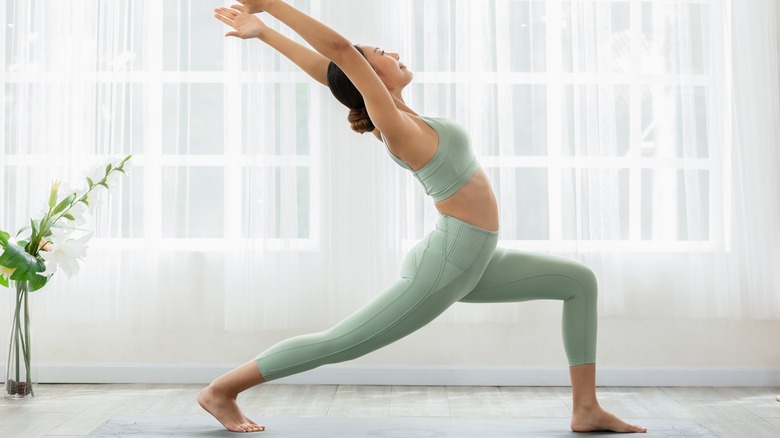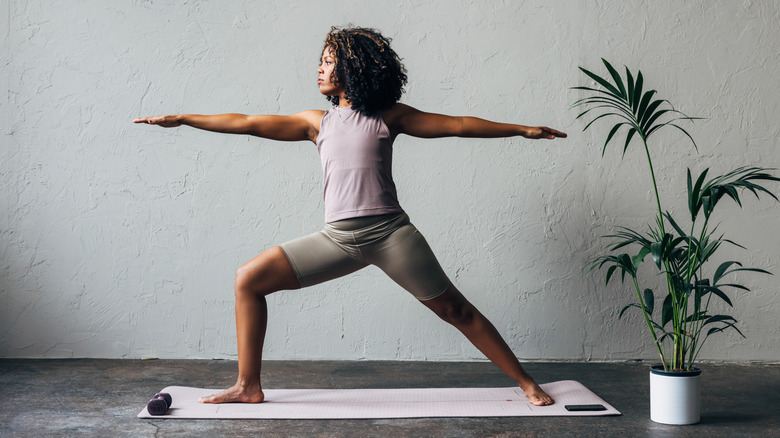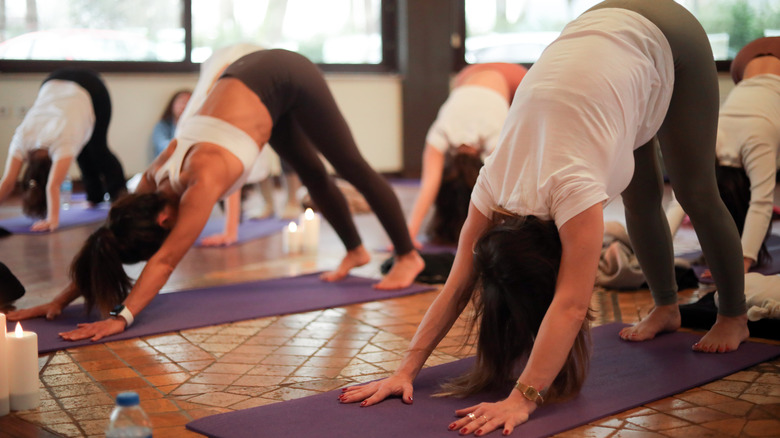The Pros & Cons Of Trying Out Power Yoga
An ancient Indian practice that strengthens the mind and the body, yoga is becoming increasingly popular as a regular form of exercise all over the world. One of the most alluring elements of yoga is that there are multiple types to explore, each with their own strengths and weaknesses. Different yoga variations may appeal to different people; for instance, restorative yoga is often a go-to exercise form for those looking to unwind, while Anusara yoga may be ideal for people more concerned with spiritual improvement than physical rewards. Also popular is power yoga, which Healthline defines as being within the discipline of Vinyasa yoga.
The goal with power yoga is to develop physical strength while transitioning between poses. In a typical power yoga class, the instructor will have you build a connection between your breathing and the various poses of your body, which will flow from one to another quickly. Because of its fast-paced and somewhat strenuous nature, power yoga typically burns more calories than other forms of yoga while simultaneously building endurance and stamina. But despite these and other health benefits, it may not be for everyone. The biggest drawback to power yoga is that it requires a larger commitment of time and energy than other yoga disciplines.
Why should you try out power yoga?
As practitioners quickly move between poses for up to 90 minutes during a power yoga session, they naturally burn more calories than they would in less active forms of yoga. It can therefore be a great choice of exercise for someone whose goal is weight loss. Of equal importance is the fact that power yoga can also improve your body image. Yoga Basics explains that Vinyasa yoga in general can lead to increased self-esteem, as the intentional breathing part of the practice can help you develop self-compassion and appreciation for your body. Additionally, power yoga promotes mindfulness, which can result in better emotional regulation and an improved mood.
According to Peloton, the moderate-intensity of a power yoga session can boost immune cell circulation, which effectively improves the functioning of your immune system. Being a cardiovascular exercise, it can also increase lung capacity while strengthening the bones at the same time. The question of how long a yoga pose should be held for best results tends to have a different answer in every discipline, and they aren't held for extreme lengths of time in power yoga. However, as they can be held for up to a minute, practitioners also experience improved core stability, balance, and mobility. Another drawing point is the fact that power yoga is a full-body workout. While you can get tailored sessions that include poses that only work particular muscle groups, general power yoga includes a range of poses that use the entire body, per Bulldog Online.
The cons of power yoga
A typical power yoga session lasts for between 60 and 90 minutes, so the time constraints may be a disadvantage depending on your schedule. Of course, if you're doing power yoga as part of your at-home yoga journey, you can cut the session short if it begins to eat into your schedule too much. Just keep in mind that many of the benefits of power yoga, including extensive calorie burning and the building of stamina, come from the longer time frame of the sessions.
Due to power yoga being so fast-paced, it isn't an overly accessible form of yoga for beginners or those who aren't moderately fit already. As Healthline confirms, a basic knowledge of Vinyasa poses is generally required to make the most out of the class. If you're completely new to yoga, you'll likely need more time than is given here to completely get the hang of all the poses. As well as not being accessible to beginners, power yoga is also not recommended for people who have shoulder or hamstring injuries, heart problems, or eye problems, as these ailments may prevent you from performing the poses properly, which may lead to injury (via Bliss Flow). Those who are pregnant should also avoid power yoga. While power yoga undeniably comes with a range of mental and physical benefits, these disadvantages mean it's not for everyone. Luckily, there are several other types of yoga to explore if power yoga isn't for you.


